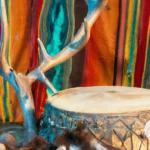Shamanism is an ancient spiritual practice that has been part of human culture for thousands of years. While it takes many forms around the world, Siberian Shamanism is one of the most well-known and studied. In this comprehensive guide, we will explore Siberian Shamanism in depth and compare it to other forms of shamanism from around the world. From African to Native American to Asian traditions, we’ll examine the similarities and differences in belief, ritual, healing, and societal role. By the end of this article, you’ll have a greater understanding of the complexities of shamanism and how it has evolved across cultures.
Definition of Shamanism
Shamanism is a spiritual practice that involves an individual seeking to interact with the spirit world in order to gain insight, communicate with spirits, and heal themselves or others. The word “shaman” comes from the Tungus tribe in Siberia, and it refers specifically to a spiritual leader who uses their abilities to help their community.
Shamanism is found in many different cultures around the world, and it takes different forms depending on where it is practiced. However, there are certain core elements that are common to most shamanic practices. One of these is the belief that the world is inhabited by spirits. These spirits can be either benevolent or malevolent, and they can have an impact on human affairs. Another common feature of shamanism is the use of rituals and ceremonies to communicate with the spirit world.
Shamanism can help people to understand themselves and their place in the world, as well as to gain insight into their spiritual and emotional lives. In some cases, it can also be used to address physical ailments. One of the things that separates shamanism from other spiritual practices is the central role of the shaman, who acts as an intermediary between the physical and spiritual worlds. Shamans typically receive their powers through a special initiation, and they may use various tools and techniques to help them perform their duties.
While shamanism is often associated with traditional societies and indigenous cultures, it is still practiced today in many parts of the world. Some people have adapted shamanic practice to fit modern circumstances, while others have sought to preserve the traditional methods. Regardless of the form it takes, shamanism continues to offer people a way to connect with the spiritual world and to gain a deeper understanding of themselves and their surroundings.
Siberian Shamanism
Siberian Shamanism is a spiritual practice that has been around for thousands of years in Siberia, a region in northern Asia. It is characterized by traditional beliefs and rituals that involve communication with the spirits to understand the world and heal the sick. Here are some of the key features of this spiritual practice:
| Spiritual Belief | In Siberian Shamanism, it is believed that the natural world is populated by various spirits with whom shamans can communicate. The spirits are believed to inhabit animals, plants, rocks, and natural phenomena like thunder and lightning. The spirits are honored and respected, and shamans use various rituals and ceremonies to communicate with them. |
|---|---|
| Shamanic Journey | The shamanic journey is a technique used by Siberian shamans to enter an altered state of consciousness. This is done using various methods, including chanting, singing, or using plants with psychoactive properties. During the journey, the shaman communicates with the spirits in order to gain insight, knowledge, or healing. |
| Rituals and Ceremonies | Siberian shamans use rituals and ceremonies to communicate with spirits and seek their guidance. The rituals include singing, drumming, and dancing in a specific way to establish a connection with the spirits. The ceremonies are often performed in natural locations, such as open fields, forests, or near rivers. |
| Role of the Shaman | The shaman is a central figure in Siberian Shamanism, as they are believed to have the ability to communicate with the spirits. For this reason, they are respected and often sought out for their healing abilities. They are known for their knowledge of plants and herbs, as well as their ability to interpret dreams and perform divination. They also serve a social role, often leading ceremonies and providing guidance and counseling to their community. |
| Tools and Instruments | Siberian shamans use various tools and instruments in their practice, including drums, rattles, and costumes. These tools are believed to help in establishing a connection with the spirits and are often richly decorated with symbols and colors that hold special significance. |
| Modern Applications | Siberian Shamanism has experienced a revival in recent years, both in Siberia and beyond. Its teachings are often used in ecological and environmental movements, as they advocate for the preservation and respect for the natural world. Additionally, the practice has been integrated into many forms of alternative healing therapies, such as crystal healing and meditation. |
If you want to learn more about Siberian Shamanism, you can read our Siberian Shamanism Introduction article that further explores this ancient practice.
Other Types of Shamanism
Other Types of Shamanism: Shamanism is a practice that has existed for thousands of years in many different cultures around the world. African Shamanism involves the use of drumming, dancing and other rituals to enter trances and communicate with spirits. Native American Shamanism typically involves a deep connection to nature and the use of sweat lodges for purification. Central and South American Shamanism often involves the use of hallucinogens like ayahuasca to connect with the spirit world. Asian Shamanism incorporates practices like acupuncture and herbal medicine. Australian Aboriginal Shamanism involves singing and dancing to connect with the Dreamtime. While all forms of Shamanism share common beliefs and practices, each culture has its own unique methods for communicating with and harnessing the power of the spirit world. To learn more about one specific form of Shamanism, check out this article on Siberian Shamanism.
African Shamanism
African shamanism is a diverse and multifaceted practice, with each African culture having their unique traditions and beliefs. African shamanism includes various animistic and polytheistic religions that honor ancestors, nature spirits, and water spirits.
One of the key features of African shamanism is that it emphasizes communing with spirits through dancing, drumming, and chanting. These rituals induce trance-like states where the shaman can communicate with the spirits and ancestors and gain insight or heal their community. For example, the sangoma, a traditional healer in South Africa, uses dance and drumming to help the patient to overcome spiritual imbalances.
Another characteristic of African shamanism is the importance of divination in the shamanic practice. Divination is used to seek guidance from spirit guides, ancestors, and deities to understand the source of problems and find solutions. Divination methods include throwing bones, using shells, and interpreting dreams.
African shamanism also places significant importance on medicinal plants and herbs. Traditional healers, such as the South African inyanga, use plants to treat various illnesses, including physical and spiritual ailments.
African shamanism differs drastically from Siberian shamanism, where the focus is less on ancestral communication and divination and more on journeys to the spirit world to gain insight and healing for individuals and the community. Despite these differences, both systems share a deep respect for the natural world and its spiritual inhabitants.
Internal link: If you’re interested in the nature spirits of Siberian shamanism, you can check out this article detailing different Siberian shamanic beliefs about nature spirits – Siberian Shamanic Beliefs About Nature Spirits.
Native American Shamanism
Native American Shamanism is a form of shamanism that is deeply rooted in the culture and history of the indigenous peoples of North America. It has been practiced for thousands of years and is characterized by a close relationship with nature and a belief in the interconnectedness of all things.
Belief in Spirits: In Native American Shamanism, spirits are integral to the practice of shamanism. Shamans communicate with spirits such as animal spirits, nature spirits, and ancestral spirits. These spirits act as guides and helpers in healing, divination, and other shamanic practices. The spirits are seen as equal partners in the shamanic journey, and the shaman must respect and honor them.
Use of Ritual and Ceremony: Ritual and ceremony play an important role in Native American Shamanism. Sweat lodges, vision quests, and sacred pipe ceremonies are just a few examples of the practices used in Native American Shamanism. These rituals are steeped in symbolism and are used to honor the spirits, connect with nature, and promote healing.
Methods of Healing and Divination: Native American Shamanism has a wide range of healing and divination techniques that are used to restore balance and harmony. These practices may include the use of herbs, crystals, and other natural remedies. Native American shamans also use drumming, chanting, and other forms of sound therapy to induce trance states and facilitate healing.
Role of the Shaman in Society: Native American shamans are considered to be powerful spiritual leaders and healers within their communities. They are responsible for maintaining balance and harmony within the community, helping individuals to connect with their spiritual selves, and fostering a deep respect for nature and the natural world.
Impact of Culture and Geography: The practice of Native American Shamanism has been shaped by the culture and geography of the indigenous peoples of North America. The rituals, practices, and beliefs of Native American Shamanism are intricately tied to the land and the natural world.
Modern Applications: Today, Native American Shamanism continues to be practiced by indigenous communities throughout North America. It has also gained popularity among non-Native Americans as a form of alternative healing and spirituality. However, it is important to approach these practices with respect and sensitivity, and to seek guidance from a trained practitioner.
Native American Shamanism offers a unique perspective on the practice of shamanism. Its close relationship with the natural world, emphasis on spirituality and community, and diverse methods of healing and divination make it an important and powerful form of shamanism.
Central and South American Shamanism
Central and South American Shamanism has been practiced for thousands of years and has its roots in the ancient cultures of the region. Shamans in Central and South America are known as curanderos and are revered for their ability to heal and communicate with the spirit world. They use a wide range of tools and techniques to achieve their goals, including the use of hallucinogenic plants like ayahuasca.
One of the most fascinating aspects of Central and South American Shamanism is the central role that hallucinogenic plants play in their practices. These plants are used to induce a trance-like state that allows the shaman to communicate with the spirit realm. For example, ayahuasca is a powerful hallucinogen that is used in shamanic ceremonies throughout the region. It is known for its ability to induce intense visions and spiritual experiences that are said to provide insight and wisdom.
Another characteristic of Central and South American Shamanism is the use of ritual and ceremony to connect with the spirit world. Ceremonies often involve chanting, drumming, dancing, and other forms of music and movement that are believed to help the Shaman connect with the spirits. Once in contact with the spirit realm, the Shaman is able to gain insight, perform healings, and other spiritual work.
Like Siberian Shamanism, Central and South American Shamanism also places a strong emphasis on the healing powers of the shaman. Curanderos are sought out for their ability to treat physical ailments as well as spiritual issues. They may use a variety of techniques that draw on natural remedies, ritual, and spiritual practices to help individuals achieve balance and wellness.
In Central and South American Shamanism, Shamans also play an important role in society, often serving as healers, community leaders, and mediators. They are respected members of their communities and are often called upon to help with a range of issues, from health problems to disputes between individuals.
Finally, it’s worth noting that Central and South American Shamanism is deeply influenced by the cultural and geographical landscape of the region. For example, many curanderos use the traditional healing practices of their indigenous ancestors, which have been passed down for generations. Others have incorporated aspects of Catholicism into their practices, creating a unique blend of spiritual beliefs.
Central and South American Shamanism is a rich and complex tradition that has been practiced for thousands of years. While there are many similarities between this tradition and Siberian Shamanism, Central and South American Shamanism has its own unique features and practices. From its use of hallucinogenic plants to its focus on ritual and community, this tradition offers a fascinating glimpse into the spiritual history of the region.
Asian Shamanism
Asian Shamanism encapsulates different regions of Asia such as China, Korea, Japan, and Vietnam, each with their specific practices and traditions. Although these countries have their unique approach to shamanism, they also share many similarities that distinguish them from other forms of shamanism.
In Chinese shamanism, the shaman or wu is an intermediary between the human world and the spirit world. Wu performs healing rituals, divination, and communication with spirits, and they were highly respected by the Chinese society. The Korean shaman, or mudang, connects with the spirits through music and dance and performs rituals for the deceased or to cure illnesses.
In Japan, there are two types of shamanism – miko and onmyoji. Miko are female shamans who act as intermediaries between the gods and humans may provide divination for the community. Onmyoji shamans focus on divination and fortune-telling, and they use Yin-Yang principles to balance the spiritual world.
In Vietnam, there are shamans called “Thay” or “Vu”, who perform physical healings and protection rituals and ceremonies for the community. They believe that negative energy can cause illness, so it is their goal to restore the balance of the spirit world and protect their people.
While there is a diverse set of beliefs and practices, the common theme in Asian shamanism is the belief in communication with spirits to maintain harmony between the natural and human worlds. Shamans in Asian countries aim to connect with their communities, providing the necessary services of healing, divination, and spiritual guidance.
Asian shamanism has impacted other aspects of Asian culture such as art, music, and literature. Many Asian artworks manifest shamanic themes and symbols. The traditional music and dance techniques in Asian countries were used primarily for shamanic rituals, demonstrating the deep connection to their culture’s mythology.
Asian shamanism has a rich history and vast array of practices, which have impacted the culture of Asia. Although there are differences and geographical distinctions, Asian shamanism shares the same underlying idea of connecting humans and the spiritual world. If you want to know more about the shamanic practices in Siberia, check out “Siberian Shamanic Journey Features”.
Australian Aboriginal Shamanism
Australian Aboriginal Shamanism is practiced by the indigenous people of Australia, who have been living there for over 65,000 years. Their belief system is based on the idea that everything in the natural world has a spirit and that these spirits can interact with humans. The shaman, or ‘ngangkari’, is a central figure in Aboriginal culture, and their role is to connect with these spirits for the benefit of the community.
Belief in Spirits: Like other forms of shamanism, Australian Aboriginal Shamanism also believes in the existence of spirits. Every living being, including plants and animals, has a spirit in the Aboriginal culture, and these spirits are essential for shamanic practices.
Use of Ritual and Ceremony: Aboriginal shamans use ritual and ceremony to connect with the spirits. One of the most popular rituals is the ‘Dreamtime,’ which is a sacred time in Aboriginal culture where they believe that the world was created.
Methods of Healing and Divination: Aboriginal shamans use a variety of methods to heal their patients. These include touch therapy, herbs, and singing sacred songs. They also use divination techniques, like reading the state of the flames in a fire to understand the future.
Role of the Shaman in Society: The shamans have various roles in Aboriginal society, including maintaining the spiritual well-being of the community, performing healing practices, and guiding people in non-Aboriginal cultures to understand and appreciate their shamanic practices.
Impact of Culture and Geography: Aboriginal Shamanism is closely tied to Australian culture and geography. The natural environment is believed to have a significant effect on the beliefs of the Aborigines. For example, the Aboriginals believe that Uluru, the sacred rock formation in central Australia, is a spiritual place that can connect people with the spirits.
Modern Applications: Similar to Siberian Shamanism, Aboriginal Shamanism is still practiced today, not only by the Aborigines but also by non-Aboriginal people. Modern practitioners have also incorporated new forms of technology in their shamanic practices, like using smartphones to record and share their sacred songs.
Australian Aboriginal Shamanism is a diverse and complex belief system that has been practiced for thousands of years. It has had a significant impact on the culture and geography of Australia and continues to be an essential part of Aboriginal life. Although it shares similarities with Siberian Shamanism and other forms of shamanism, it is a unique and distinct practice that is a vital part of the world’s spiritual heritage.
Comparing Siberian Shamanism with Other Forms of Shamanism
Siberian Shamanism, like other forms of shamanism, centers around the belief in spirits and the ability of the shaman to communicate and interact with these spirits. However, there are distinct differences between Siberian Shamanism and other types of shamanism. For example, Siberian shamans often work with reindeer herds and use them as both a source of food and a means of transportation, whereas in Central and South American Shamanism, the focus may be more on plant medicine and psychoactive substances. The use of ritual and ceremony also varies between cultures, with African Shamanism having a strong tradition of dance and song, while Siberian Shamanism may feature drums and other instruments unique to their culture. However, despite these differences, all forms of shamanism share the common thread of connecting with the spiritual realms for healing and guidance.
Belief in Spirits
In Siberian Shamanism, spirits play a central role. The Siberian shamans believe that there are spirits in all natural phenomena, such as trees, rocks, rivers, and animals. The spirits can be good or bad, and they can possess individuals. The shaman’s role is to communicate with the spirits and gain their favor. This is done through ritual, song, dance, and drumming. The shaman uses healing techniques to cure people of illnesses caused by negative spirits.
In African Shamanism, the belief in spirits is also important. The African shamans believe that spirits can be found in everything, including ancestors, animals, and objects. The spirits can be good or bad, and they can influence the lives of people. The role of the African shaman is to communicate with the spirits to gain their favor and provide healing to the people.
In Native American Shamanism, the belief in spirits is also a fundamental aspect. The Native American shamans believe that everything in the world is alive and has a spirit. These spirits are guides and helpers that can be called upon for healing, guidance, and protection. The shaman’s role is to communicate with the spirits and act as a mediator between the spirit world and the physical world.
In Central and South American Shamanism, the belief in spirits is also pervasive. The Central and South American shamans believe in spirits that are both good and evil. The shamans are responsible for working with the spirits to bring balance to the world and provide healing to the people. The shamans use sacred plants such as ayahuasca and peyote to facilitate communication with the spirit world.
In Asian Shamanism and Australian Aboriginal Shamanism, the belief in spirits is also prevalent. In Asian Shamanism, spirits can be found in everything, including inanimate objects. The Asian shamans use divination to communicate with the spirits and seek their guidance. In Australian Aboriginal Shamanism, the spirits are believed to have created the world and they are responsible for the natural balance. The
Subscribe to Our Newsletter
Sign up to receive the latest news and updates.
While the belief in spirits is central to all forms of shamanism, the way in which the spirits are viewed and interacted with varies by culture. In Siberian Shamanism, the spirits are believed to be present in the natural world and can be communicated with through ritual and ceremony. For more information about reindeer and other aspects of Siberian Shamanism, refer to our comprehensive guide.
Use of Ritual and Ceremony
The use of Ritual and Ceremony is a critical aspect of shamanic practices across the world. Siberian Shamanism employs numerous rituals, such as the “consecration of the drum” and the “Siberian Fire Ceremony,” during which shamans connect with the spirits and receive guidance.
Similarly, African Shamanism has numerous rituals centered around dancing and music. In Native American traditions, sweat lodges are used to purify the mind and body, while Central and South American shamanism involves the use of Ayahuasca ceremonies.
In Asian shamanism, rituals like “burning offerings to ancestors” and “tea ceremonies” are commonly practiced. The Australian Aboriginal shamans use music and dance in their healing ceremonies.
While the types of rituals and ceremonies used in shamanism across the world may vary, they often serve similar purposes, such as connecting with the spirits or offering healing and guidance. Shamanic tools and instruments, such as the Siberian shamanic drum or the African shamanic rattle, are often used during these rituals to aid in the process of connecting with the spirit world.
It is also worth noting that modern applications of shamanism may incorporate new technology or alternative forms of ceremony. For example, Siberian Shamanism has adapted to modern times with the use of the internet to conduct remote healing sessions, as discussed in more detail in our article on Siberian Shamanism in modern times.
The use of Ritual and Ceremony is a fundamental aspect of shamanism across the world, providing a framework for connecting with the spirit world and offering guidance and healing to communities.
Methods of Healing and Divination
Methods of healing and divination vary greatly among different forms of shamanism. In Siberian Shamanism, the shaman might use tools like the frame drum, shamanic staff, and shamanic symbols to help them enter a state of trance and connect with the spirit world. Once they have entered this state, they may perform a variety of methods to help heal their patient, such as singing, chanting, or using rattle or drum beats to restore spiritual balance.
In African Shamanism, the methods of healing and divination can vary quite widely depending on the particular tribe or shaman. Some of the most common practices include using herbs and natural medicines to heal the sick, as well as divining techniques such as casting bones or using crystals to communicate with the spirit world.
Native American Shamanism also uses a wide variety of methods to heal and divine. Many Native American shamans incorporate the use of herbs and natural remedies into their healing practices, as well as the use of sacred ceremonies and rituals to help connect with the spiritual world. Sweating lodges, vision quests, and other intense rituals are often used as a means of spiritual purification and healing.
Central and South American Shamanism also incorporate a wide range of methods and practices. Shamans in this area often use plant medicines, such as ayahuasca, to enter into altered states of consciousness and divination. Ceremonies often involve large groups of people gathering to sing, dance, and perform other rituals aimed at healing or connecting with the divine.
Asian Shamanism, including practices in Tibet and Mongolia, often use complex rituals and ceremonies as a way to access the spiritual realm. These include singing, chanting, and the use of instruments like gongs and bells. Many Asian shamanic practices also incorporate the use of meditation and various martial arts techniques to help achieve spiritual balance and harmony.
Finally, Australian Aboriginal Shamanism often involves the use of music and dance to enter into a trance state and communicate with the spiritual realm. The shamans may use a variety of natural remedies and medicines to help heal the sick and injured.
The methods of healing and divination used in shamanic practices vary widely depending on the culture and region. However, the common thread among all these practices is the belief that the shaman has the ability to communicate with the spirit world and use this ability to bring about healing and balance within the community.
Role of the Shaman in Society
The role of the shaman in society varies greatly among different cultures and forms of shamanism. However, these spiritual leaders generally hold an important and respected position within their communities.
In Siberian shamanism, the shaman is often seen as a mediator between the spirit world and the physical world. They may be called upon to communicate with spirits on behalf of the community, to offer guidance or advice, or to perform healing rituals. In some cases, the shaman may also be a political leader, wielding significant influence in decision-making processes.
In African shamanism, the role of the shaman is also multifaceted. They may be involved in healing, divination, or protective rituals, and may also serve as a community leader or mediator. However, the specific duties and responsibilities of the shaman can vary widely based on the particular cultural context.
Among Native American cultures, the shaman may be known by a variety of names and hold a range of functions. They may be involved in healing, spiritual guidance, or communication with the spirit world, to name just a few examples. In some cases, the shaman may also be responsible for mediating conflicts within the community or for delivering messages or prophecies.
Central and South American shamanism is similarly diverse in terms of the role played by shamans. In some cases, they may be primarily focused on the healing of physical or spiritual ailments, using herbs, plants, or other natural remedies to treat their patients. In other contexts, the shaman may be called upon to provide guidance or counsel to members of the community seeking answers or direction.
Asian shamanism likewise encompasses many different forms and practices. In some cultures, the shaman may be seen as a healer or diviner, while in others they may hold a more exalted spiritual role. In some cases, the shaman may also serve as a teacher or guide, passing on their knowledge of spiritual or medical practices to others in the community.
Finally, in Australian Aboriginal shamanism, the role of the shaman is often closely tied to the natural world. They may be involved in rituals or ceremonies that seek to maintain harmony between humanity and the environment, or to appease spirits that inhabit particular places or objects.
The role of the shaman in society varies widely across cultures and forms of shamanism. However, these figures tend to play an important and respected role within their communities, serving as spiritual guides, healers, or political leaders, and facilitating communication between the physical and spiritual worlds.
Impact of Culture and Geography
The impact of culture and geography on shamanism is significant, as it influences the beliefs and practices of shamans in different regions. Let’s explore the different ways in which culture and geography have an impact on shamanism.
Culture: The culture of a particular region can have a significant impact on the beliefs and practices of shamans. For example, in many African cultures, the shaman is referred to as a “witch doctor” and is often feared and revered for their abilities to heal and cast spells. In contrast, in many Asian cultures, the shaman is seen as a spiritual leader and a bridge between the physical and spiritual worlds.
Geography: The geography of a region can also have an impact on shamanism. For example, in Siberia, where the climate is harsh and the terrain is rugged, shamans often rely on the use of drums, chants, and other forms of ritual to connect with the spirits. In contrast, in the Amazon rainforest, where the climate is more temperate and the terrain is lush, shamans often rely on the use of healing plants and natural remedies to connect with the spirits.
Other factors that can impact shamanism include language, history, and the influence of other religions. For example, the impact of Christianity on shamanism in Native American cultures has been significant, leading to the decline of traditional shamanic practices in some regions.
The impact of culture and geography on shamanism cannot be understated. It has a significant influence on the beliefs, practices, and perceptions of shamans in different regions around the world.
Modern Applications
Modern applications of shamanism have evolved in recent years. In Siberia, various modernized versions of shamanism have emerged, such as neo-shamanism, which aims to apply traditional shamanic practices in modern, urban settings. Neo-shamanism involves practices such as vision quests, sweat lodges, and drumming circles, which are aimed at personal transformation and self-discovery.
In other parts of the world, shamanism has been incorporated into various therapeutic and healing practices. For example, in the United States, Native American shamanism has been used in substance abuse treatment programs and psychotherapy. In South America, ayahuasca, a hallucinogenic plant brew used in shamanic ceremonies, has gained popularity as a treatment for addiction, depression, and PTSD.
Shamanic practices have been adapted for environmental and social justice causes. Eco-shamanism involves using shamanic techniques to communicate with nature and advocate for its protection. Some shamanic practitioners also use their skills for social justice causes and activism.
Finally, shamanic practices have found a place in the world of spirituality and personal growth. Many people turn to shamanic practices as a way to connect with their spiritual selves and find meaning in their lives. Online courses and retreats on shamanic practices have become increasingly popular in recent years, allowing people to learn and experience shamanism in their own time and from the comfort of their own homes.
Modern applications of shamanism have evolved in various ways, from personal growth to healing and activism. These applications show the continued relevance and adaptability of shamanic practices in today’s world.
| Modern Applications of Shamanism |
|---|
| Neo-shamanism – applying traditional shamanic practices in modern, urban settings |
| Therapeutic and healing practices – incorporating shamanism into substance abuse treatment programs, psychotherapy, and ayahuasca ceremonies |
| Eco-shamanism – using shamanic techniques to advocate for environmental protection |
| Social justice and activism – using shamanic practices to support social justice causes |
| Spirituality and personal growth – using shamanic practices to connect with one’s spiritual self and find meaning in life |
| Online courses and retreats – providing accessible ways for people to learn and experience shamanism |
Conclusion
In conclusion, it is important to note that while Siberian Shamanism may have similarities with other forms of shamanism, it also has distinct differences. The belief in spirits and the use of ritual and ceremony are common across all forms of shamanism. However, the methods of healing and divination, the role of the shaman in society, and the impact of culture and geography vary greatly around the world.
Siberian Shamanism places great emphasis on the shaman’s ability to communicate with spirits and serve as a bridge between the physical and spiritual worlds. The use of drums and other ritual instruments is also an important aspect of Siberian Shamanism. In comparison, African and Native American Shamanism often involves the use of dance and music for healing and spiritual trance.
Regarding healing and divination, Siberian Shamanism often involves the use of herbal medicines and animal parts, while Central and South American Shamanism uses hallucinogenic plants in their practices. The role of the shaman in society also varies greatly. In some cultures, the shaman is highly respected and revered, while in others they may be viewed as outcasts.
The impact of culture and geography cannot be ignored when comparing different forms of shamanism. For example, Australian Aboriginal Shamanism is heavily influenced by the surrounding landscape and the Dreamtime creation stories, while Asian Shamanism is often influenced by Buddhism and Taoism.
In modern times, shamanism has evolved and adapted to fit with modern society. Some forms of shamanism have been integrated into modern medicine, while others are still practiced in traditional settings. The popularity of shamanism has also increased, with individuals seeking spiritual guidance and healing outside of traditional Western medicine.
Overall, comparing Siberian Shamanism with other forms of shamanism highlights the diversity and richness of the world’s spiritual traditions. Each form of shamanism has its unique practices and beliefs that offer valuable insights into humanity’s relationship with the natural world.
Frequently Asked Questions
FAQs
Below are some commonly asked questions about comparing Siberian Shamanism with other forms of Shamanism:
1. Can Shamanism be practiced as a religion?
Shamanism is not always practiced as a religion. Rather, it is often viewed as a way of life or spiritual practice that is often integrated with other belief systems.
2. What is the role of the community in Shamanism?
Community plays a vital role in Shamanism. Shamanism is often a community-based practice, and communities often rely on shamans for spiritual guidance and teachings. The community also provides support for the shaman during their healing and divination work.
3. How do different forms of Shamanism view the role of the shaman?
Different forms of Shamanism view the role of the shaman differently. In some cultures, the shaman is viewed as a mediator between the spiritual and physical worlds. In other cultures, the shaman’s role is to act as a healer, and in others still, the shaman might play the role of a seer or diviner.
4. Is Shamanism a legitimate spiritual practice?
Yes, Shamanism is a legitimate spiritual practice with a rich history and tradition. It is recognized as a form of spirituality by anthropologists, historians, and religious scholars.
5. How does Siberian Shamanism differ from other forms of Shamanism?
Siberian Shamanism differs from other forms of Shamanism in several ways, including its emphasis on the use of percussion instruments, the use of reindeer as spiritual animals, and the belief in clan spirits.
6. How are spirits viewed in Shamanism?
In Shamanism, spirits are seen as entities that can have both positive and negative impacts on humans and nature. Spirits can be contacted and worked with through shamanic rituals and practices.
7. What is the role of ritual in Shamanism?
Ritual plays a significant role in Shamanism. It is often used to contact and communicate with spirits, to transform consciousness, and to heal the physical, mental, and spiritual self.
8. How has Shamanism been impacted by modernization and globalization?
Modernization and globalization have impacted Shamanism in several ways, including changes in traditional practices due to the influence of Western culture and religion and an increase in interest in Shamanism as a spiritual practice among those who are not traditionally part of Shamanic communities.
9. Can anyone practice Shamanism?
While anyone can learn about Shamanism and some of its practices, becoming a shaman requires extensive training, often passed down through generations from a family member who is a practicing shaman.
10. How do Shamanic practices relate to modern mental health practices?
Some modern mental health practices, such as mindfulness meditation and exposure therapy, have similarities to Shamanic practices. However, it is important to note that Shamanism should not be seen as a replacement for modern mental health practices and that individuals should consult with a licensed mental health professional if they are struggling with mental health issues.










